- Home
- Peter Matthiessen
Sand Rivers Page 2
Sand Rivers Read online
Page 2
Under the hills the plane banked toward the north, following the small Behobeho tributary. In an open plain of game trails and scattered trees stood the white concrete rectangle, inset with a marble plaque, that marks the grave of Frederick Courtenay Selous, naturalist, elephant hunter, and explorer, after whom the Reserve was named in 1922. Selous, who was once "white hunter" for Theodore Roosevelt, was a captain in the 25th Royal Fusiliers, "the Legion of Frontiersmen" - "bush types, mostly," according to Nicholson - part of a far superior British force tied up for years by guerrilla troops under the command of the remarkable Count von Lettow-Vorbeck, in a useless battle to control the bundu or bush of this wild country. The elusive German and Selous, far out on the uttermost frontier of the Great War, had the time and perspective to deal with each other as gentlemen, and von Lettow, in his memoirs, makes the claim that he once had Selous in his rifle sights but let him go. A common soldier, it appears, was less impeccable, and Selous died of a wound received at Zogoware, not far from this place, in the course of the British advance to the Rufiji in 1917.
The Germans had established a game reserve in this region as early as 1905, and the several reserves established by 1912 were known collectively to the Africans as Shamba ya Bibi, or "Wife's Land" - the Kaiser Wilhelm, on a romantic impulse, having made it a huge and shaggy present to his wife. No Germans inhabited the region (their forts were nearer the coast, at Utete and Liwale) although in 1916-17 they set up gun emplacements along the Rufiji and the Behobeho rivers, where old horseshoes, cartridge cases, and the like may still be found. They also hauled an enormous steam engine all the way inland from Kilwa, using hundreds of unfortunate Africans as draft animals, to grind millet to make bread for their black soldiery; the abandoned steam engine still serves to commemorate the Second Reich in the Selous Game Reserve, as the collected reserves were named in 1922 by the Game Department established that year by the British. In those days the Reserve was confined to a tract of approximately one thousand square miles, and not
SAND RIVERS
until a decade later, with the advent of an inspired young game ranger named C. J. P. lonides, did it begin to assume the imposing shape that it has today.
lonides - or "Iodine", as he came to be known throughout East Africa - has been called "the father of the Selous" by no less an authority than Brian Nicholson. A former British Army officer turned ivory hunter, he was briefly a white hunter working out of Arusha in 1930, then joined the Game Department in southeastern Tanganyika in 1933. Although he continued in his avid hunting, collecting rare species as far away as the Sudan and Abyssinia, lonides was a precocious conservationist. Very early in his career he began to envisage a great and self-perpetuating bastion of African wilderness, a complete ecosystem (as it is known today) where animals might wander in merciful ignorance of human beings. During a tenure of more than twenty years, he devoted his formidable energies to advancing this concept from a political point of view, exploring the region to map out some sensible boundaries and discouraging the activities of its scattered tribesmen, wherever possible by removing them entirely. **
As game ranger lonides was responsible for reducing the troublesome elephant populations of the Kilwa and Liwale districts, which were causing serious damage to the isolated shambas and small villages. With his limited staff, effective control of the wide-ranging animals was impossible, and eventually he got permission from the colonial administration to deny crop protection except to those Africans who moved to certain designated settlements. The British authorities agreed to this plan because it simplified tax collection and other administrative duties, but their support of it was only intermittent, and lonides, who had already trekked extensively over the country, suggested in 1935 that all of the western Liwale region be made a game reserve in which human settlement would be discouraged, thereby returning this wilderness, with its poor soils and abundant tsetse fly, to the wild animals for which it was best suited. In 1936 this proposal was accepted, mostly because of an outbreak of sleeping sickness in the affected area: consolidating the isolated inhabitants into communities with medical facilities, in which bush-clearing and eradication of wild animals might control "fly", made excellent sense. In the next three years, as the disease persisted, lonides kept right on walking, mapping out the proposed extensions of a vast new elephant reserve in western Liwale that would extend northward to the existing Selous Game Reserve. But when these new boundaries were laid out, in 1940, a small number of people remained inside them, and the colonial administration balked at the actual eviction of the inhabitants, lonides persisted in his policy of denying all protection to outlying shambas in western Liwale, and after three more years of severe damage the last of the Ngindo tribesmen in the southern region gave up and moved to settlements outside the Reserve. Once they were gone the
PETER MATTHIESSEN
territory was declared an elephant reserve, so that they were legally prohibited from moving back. As it turned out, all these settlements were located so far outside the boundaries that to this day, in the southern region, the country all around is virtually as uninhabited as the Selous itself.
Meanwhile the epidemic had spread north and west, leading finally to a forced evacuation of the Africans that was complete by 1947. The main outlines of the modern Selous were established by law in 1951, although important additions were subsequently made by Brian Nicholson. From start to finish, as Nicholson has written, the expansion of the Selous was resisted by the administration. "This was largely due to the fact that the people evacuated during 1946 and 1947 did not believe that they were moved because of sleeping sickness, and since most of the area became Game Reserve, the idea grew that the real reason was to facilitate the creation of this Reserve ... To the present day the Game Division is treated with considerable reserve by the people in Kilwa, Liwale, Rufiji and other Districts bordering on the Selous."
As in the case of so many great wildlife sanctuaries of Africa, the nominal factor in the final creation of the Selous Game Reserve was the tsetse fly. It has recently been argued^ that tsetse epidemics causing trypanosomiasis or "sleeping sickness" in human beings are not natural events but are brought about by the white man's interference, specifically the disruption caused by colonial policies of stock raising and land management, which upset the delicate, unknown balances between pastoral Africans and the domestic and wild animals. But the bush-loving Ngindo in the Selous had no domestic animals and were apparently content to live with tsetse; and in any case the epidemic died out almost as rapidly as it had appeared, to judge from the fact that in the 1950s and 1960s not one of the hundreds of Game Department staff who inhabited the Selous for long periods was ever to come down with the dread disease. When I asked him about this, Nicholson grinned. "That sleeping sickness wasn't quite so serious as old Iodine had the authorities believe. But he saw the great chance to accomplish what he knew was best, and he just took it." He shook his head over the boldness of the man, and 1 did too. Before lonides was finished, Shamba ya Bibi had been enlarged nearly twenty times from the original tract of approximately one thousand square miles, and its dramatic expansion was the direct result of the organized depopulation of vast areas of southeast Tanzania.
A number of people I have come across in Africa had been friendly with this extraordinary man, who died in 1967. Several books based on interviews with lonides were put together in his lifetime, since he was exceptionally colorful as well as single-minded; and he himself wrote interesting papers for the Tanganyika Notes and Records. Yet one is led by his own statements to suspect that, like most so-called "eccentrics", lonides was more presentable in books than he was in person, at least in
SAND RIVERS
any acquaintanceship at close quarters. Born in 1901 of a rich Greek family well-established in southern England, he found himself snubbed and isolated at the snobbish Rugby School because of his "foreign" origins and appearance and his sickliness, which were held accountable, no doubt, for his equally suspicious intere
st in wild creatures; eventually he was driven out of Rugby under unjust circumstances that seem to have embittered him for the rest of his life. Even at school his physical courage and stoicism when beaten were legendary, yet in order to prove himself he won a commission in the Army (where his nickname was "Greek"). But from the start he was a non-conformist, and very early in a promising career he retired from the Army, taking up solitary hunting expeditions that eventually led to his self-isolation in this most remote region of the East African bush.
From boyhood, lonides's hero - by all accounts, the only one he ever had besides Genghis Khan - was another old Rugby boy of an earlier era, an inspired amateur naturalist and "the greatest hunter of them all",'' Frederick Courtenay Selous, whose book A Hunter's Wanderings in Africa had much impressed him, and whose death in 1917 he considered a "personal loss". Though the flinty lonides would never have confessed to such sentimentality, his identification with Selous might well have affected his efforts on behalf of the Reserves.
On the ridge above Selous's grave stood Behobeho Camp, once a hunting lodge owned and operated by Ker &. Downey, who sold it to the Oyster Bay Hotel in Dar-es-Salaam in 1970. There are two other tented camps for tourists in this northeastern corner of the Selous, on the Rufiji flood plain, and there is also a temporary settlement on the Rufiji River inhabited by Norwegians who are building a bridge dam over the river at the upper end of Stiegler's Gorge. Designed to be finished about 1990, the dam will create a lake that, in the rainy season, will be about 650 square miles in extent. In itself, the lake will do little harm to wildlife, since unlike these great animal plains the region of the upper Rufiji that will be flooded is relatively barren; but the predicted influx of fishing people, and the shifting agriculture that is bound to occur along the access roads, may make it difficult to enforce the present status of what is today the largest tract in Africa in which no human being has rights of settlement or even entry. While the dam will regulate the flow of water to the rich agricultural flood plains below Stiegler's Gorge, it may also threaten the estuarine fishery of this largest river in East Africa and perhaps even the offshore fishery for prawns, and is therefore regarded with misgiving by ecologists. Meanwhile, the new road across the dam may increase the pressure for development by opening up the eastern part of the Selous.
Godfrey Mwela turned his plane east again, following the rocky
PETER MATTHIESSEN
chasm of brown swift water for perhaps five miles until it opened out on the coastal plane below. There the plane turned south, heading out across a trackless wilderness. From this place for hundreds of miles to the south and west there are no habitations or facilities of any kind except the Game Department station at Kingupira, about eighty miles away, where we were to join the rest of the safari.
Because it is near all four habitat types of the Selous - the alluvial hardpan plain of the eastern border, the riverain forest, the Terminalia spinosa woodland, and the miombo or "karoo" that covers three-quarters of the Reserve - Kingupira was chosen for the site of the Miombo Research Center, set up in 1969 under Nicholson's direction by a young ecologist named Alan Rodgers. Rodgers, whom we had visited at the University of Dar-es-Salaam, was a bluff, husky, generous man who dispensed beer as well as his own documents, and also a fascinating discourse on the ecology of the Selous, where he had spent ten years; according to Nicholson, whose admiration he reciprocates, he is the greatest living authority on the ecology of the miombo, the vast wilderness of "dry forest" or savanna woodland which extends almost from coast to coast for sixteen hundred miles across the waist of Africa. Miombo is very similar to the so-called Guinea savanna of West Africa, but whereas Guinea savanna occurs in a narrow belt between the expanding Sahara Desert and the tropical rain forest, the miombo in places extends north and south for well over a thousand miles.
Alan Rodgers, who served as Game Research Officer in the Selous from 1966 to 1976, has no lack of arguments to support his high opinion of what he has referred to as "the sleeping wilderness"."^ With dependable rainfall, great rivers, and innumerable springs and seepage points, there is abundant ground water and pasturage in the Selous Game Reserve, and since its boundaries enclose three distinct ecological units (the Serengeti cannot claim even one), there is no need for its 750,000 large animals to move out into unprotected areas, or "migrate" to water or dry-season pasture, or herd up anywhere at all in vulnerable or destructive concentrations. Most of the reserve is between 1,000 and 2,000 feet above sea level in humid country not far inland from the coast, and the vast miombo tracts are isolated from one another by the barriers of the Rufiji River and its tributaries, especially the Ruaha, Kilombero, and Luwegu. The Kilombero delta and the open country between the great rivers in the south are very beautiful, but the only scenic region accessible to visitors is the one where the tourist camps are already located, less than one hundred miles from Dar-es-Salaam. That open Behobeho country, in Rodgers's view, is "some of the most magnificent wildlife country in East Africa", while the rest of the Reserve is decidedly unsuitable even for the local people, despite chronic demands for fishing, grazing, farming, and timber rights, mostly from the Mahenge district, which are bound to increase with the completion of the dam at Stiegler's Gorge. Apart from
SAND RIVERS
the problem of tsetse, the soil almost everywhere is leached out and eroded, and the miombo woods are of little use except for the gathering of wild honey: in fact, the management of wildlife is almost certainly the most productive use to which this land could be put. The gathering of people into settlements that could be efficiently administered by the colonial government has been continued in independent Tanzania by the uiamaa villages, where the people are ver>' similarly administered in the name of socialism: except in certain places in the north, the scattered human populations along the boundaries have actually decreased as a result of uiamaa. and this removal of human pressure, together with the difficulty of access, the abundance of game outside the boundaries, and the check on human predation by the uiamaa administration, have all served to reduce poaching, which since 1960 has been negligible compared to the activities in other wildlife sanctuaries of East Africa. As a result, the Selous can claim East Africa's laigest populations of many creatures, including elephant, rhino, buffalo, hippo, and crocodile (lion and leopard, too, according to Nicholson), as well as more than three hundred and fifty species of birds and two thousand species of vascular plants. According to Rodgers, "It is unique in its size, its state of naturalness, and its variety of genetic and ecological resources."
On all sides as we flew south the (5^en woodland was broken by scattered pans of glinting water; in the southern distance, clouds of smoke rose all along the low horizon. "Whole countr>^'s going up in smoke," Nicholson muttered, not without a certain grim satisfaction; he believed strongly in the use of fire for eliminating the drv^ grass and encouraging new growth to support more animals, but having little faith in the present Game Department, he suspected that most of these fires were set by local poachers, for whom hunting was easier when the landscape was burnt.
Godfrey Mwela dodged two vultures that suddenly came sweeping down on his propellers, and seated behind him and Nicholson I could see the wrinkles of pleasure at the Warden's eyes as he laughed and joked with his fellow pilot. ("Best pilot in Tanzania, Godfrey is; helped to train him myself.") Nicholson turned to me repeatedly to point out the flat-topped terminalia trees that dominate this eastern woodland, the arrangement of termite hills around the pans, the tamarind and mahogany trees that the hills support, Nandanga Mountain in the fire haze off to the west-"That's where Iodine is buried, Peter!" he said, calling me by my name for the first time. Brian caught me by surprise; in the excitement of coming home to the Selous, he had betrayed an unabashed enthusiasm, not only to me but to Godfrey Mwela, whom he was addressing not iust civilly but as a friend.
Later, as if to readjust a mask, he made an unpleasant colonial joke, expressing surprise that one of Rick Bonham's Ken
ya staff had been with us on the plane. "Must have been back there m the dark," Nicholson said.
15
PETER MATTHIESSEN
"He didn't smile, so I never knew he was there." He laughed slyly at our cold expression. "That's the kind of joke my brothers used to make," Maria said later, "but at least they outgrew it." I was beginning to suspect that Nicholson had outgrown it, too, that being obstreperous was just another way of saying that he didn't give a damn for the world's opinion. (Or perhaps, as a friend who was raised in Dar once said to me, "As white East Africans, we feel we have to talk that way. I don't know why.")
Rain came and went. Near the Ngindo village of Ngarambe, the plane crossed over the Lung'onyo River that forms this part of the eastern boundary, then swung back again to make a good landing on the strip at Kingupira, startling two wart hogs out of the long grass.
We had scarcely unloaded when two Land Rovers turned up. The first people to jump out were two old game scouts, Saidi Mwembesi and Bakiri Mnungu, who were so delighted to see "Bwana Niki" that they clung to his hands throughout the protracted greetings that African courtesy demands: both used the respectful Arabic salutation Shikamu, meaning "I kiss your feet". Bakiri could not get over how Sandra Nicholson had grown, how time had passed. He slapped his head, hooting with laughter: "See? I'm losing my hair!" Bakiri is a local man and still works with the Game Department, but Saidi, a very tall Ngoni Zulu in a Muslim cap, had quit the Department at the same time as his Bwana and gone away to live in Dar-es-Salaam, where Rick Bonham had picked him up on the way through. ("He's a great old chap," Rick told me later, describing how Saidi had replied when the senior warden asked him if he still remembered the Selous well enough to guide Mr. Bonham down to Kingupira. "Remember the Selous?" Saidi had snorted, brandishing both hands. "The place was built with these hands! MkonoyanguV]

 Lost Man's River: Shadow Country Trilogy
Lost Man's River: Shadow Country Trilogy The Tree Where Man Was Born
The Tree Where Man Was Born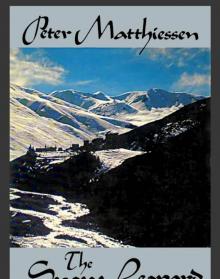 The Snow leopard
The Snow leopard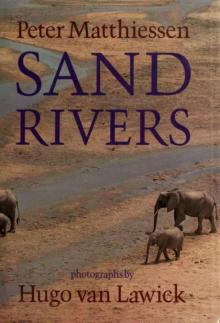 Sand Rivers
Sand Rivers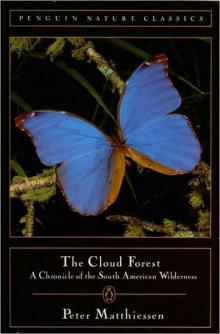 The Cloud Forest
The Cloud Forest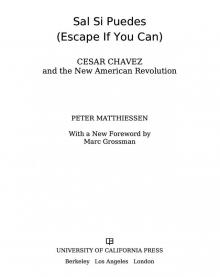 Sal Si Puedes (Escape if You Can)
Sal Si Puedes (Escape if You Can)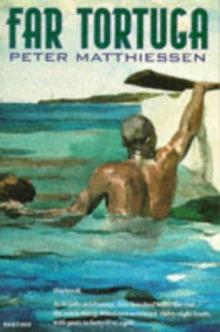 Far Tortuga
Far Tortuga Men's Lives
Men's Lives On the River Styx: And Other Stories
On the River Styx: And Other Stories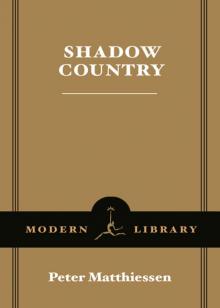 Shadow Country
Shadow Country At Play in the Fields of the Lord
At Play in the Fields of the Lord Lost Man's River
Lost Man's River Killing Mister Watson
Killing Mister Watson On the River Styx
On the River Styx